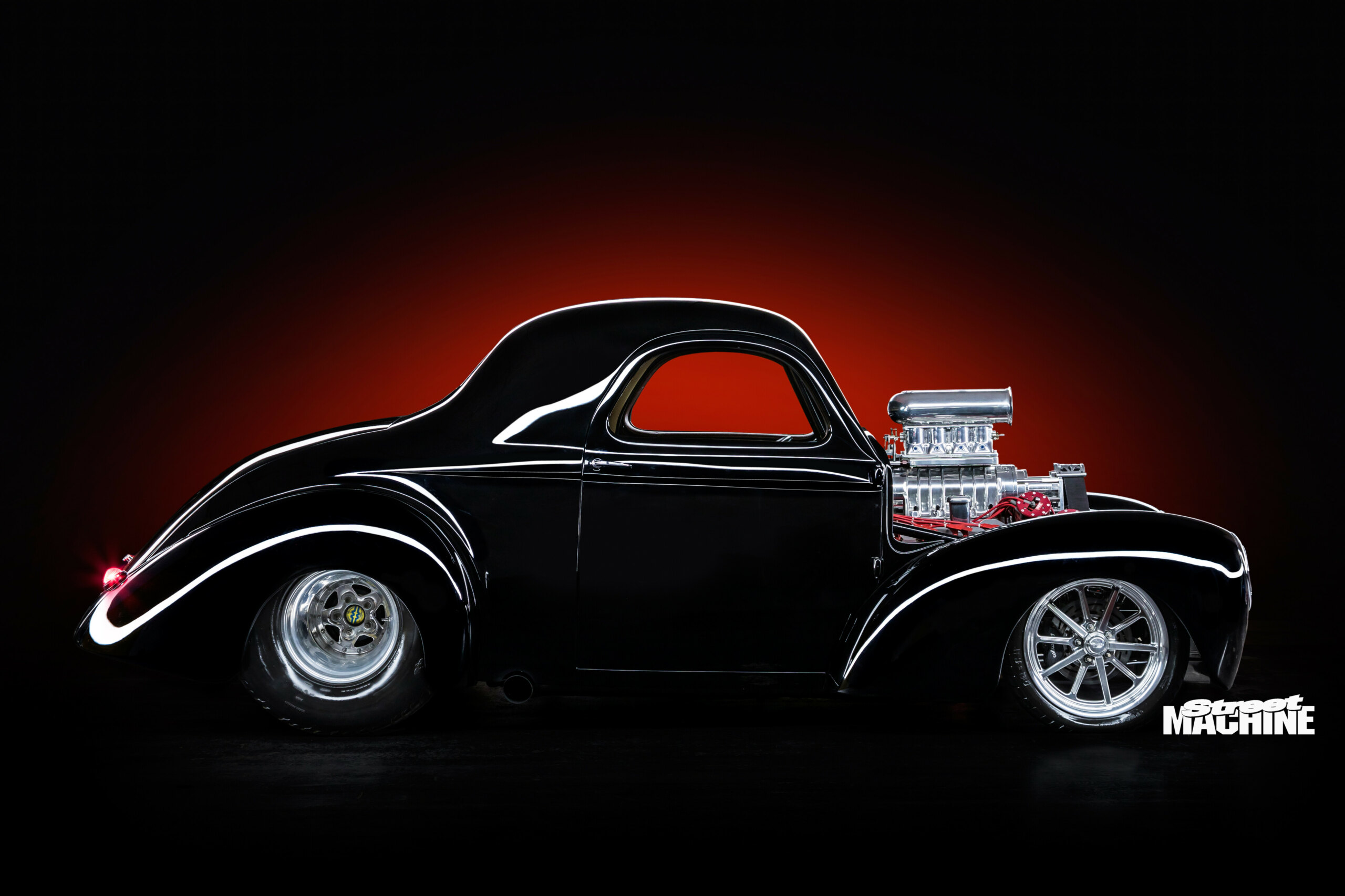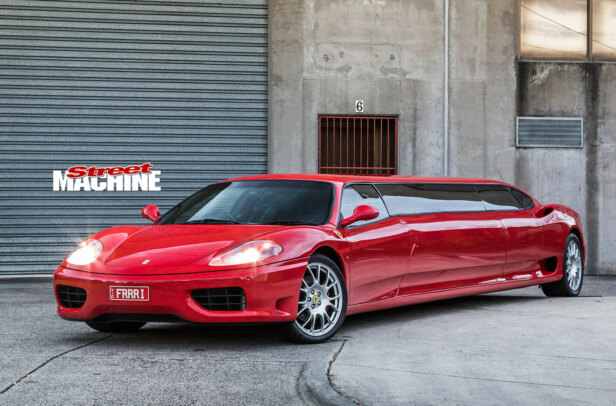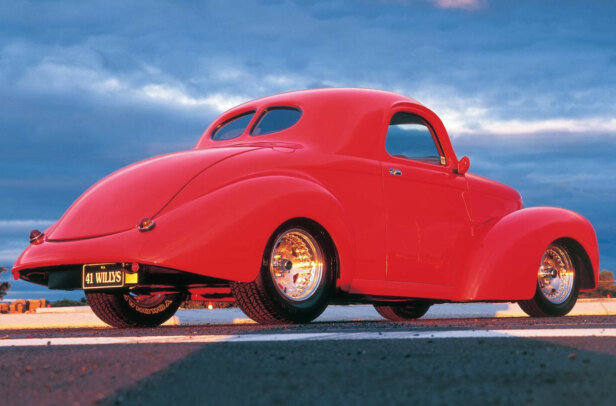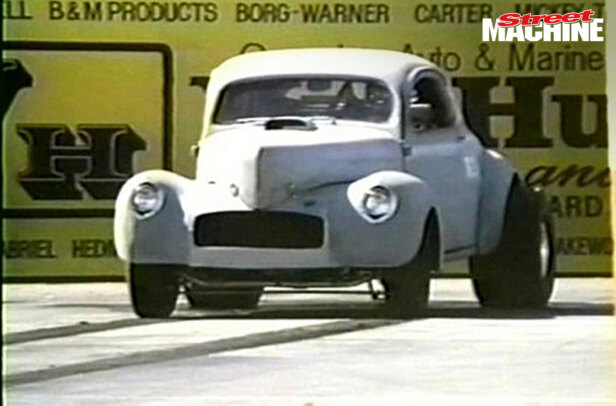When it comes to old-school cars, there are certain words that elevate pulses more than others. ‘Lightweight’ adds a new dimension to ‘Galaxie’, while ‘Super Duty’ can elevate a Pontiac from ho-hum to whoa-boy. Similarly, adding ‘blown Hemi’ to ‘1941 Willys coupe’ instantly transports hot rodders back to the mid-to-late 1960s, when drag slicks hung out of rear guards and superchargers soared through bonnets.
First published in Street Machine’s Hot Rod 18 magazine, July 2017
Scott Marshall knows the appeal all too well, as he carries the keys to this amazing 1200hp ’41 Willys, which bears a resemblance to those fearsome quarter-mile beasts of yesteryear. However, Scott’s car is much more advanced under that amazing black bodywork thanks to EFI, a full-tube chassis, and even rack-and-pinion steering with independent suspension. This is no farm-fresh gasser!
Scott’s name is one you may be familiar with, as he built a fearsome WB ute called MADNES. It stood tall among show cars back in the late 1990s thanks to the blown big-block Chev, chopped roof, bigs ’n’ littles, suicide doors and Perspex windows in the tray to show off the chassis work.
“I was playing around on the computer one night and found the Willys on YouTube,” Scott explains. “I’d had two ’41 Willys cars before, both fibreglass with big-block Chevs, and when I saw ‘Steel ’41 Willys with blown twin-plug Hemi’, it was the ultimate for me.
“The owner, Mike Virga from Sacramento, wasn’t looking to sell it at the time, but I phoned him every six months to see if he wanted to sell it. Then, one day, my phone rang at 2am and he offered me the car. I was on a plane to California that day, went to Sacramento to see the car, and then flew back that night.”
Mike had actually started the project with his father some years before as it was always his father’s dream to have a wild Willys. Unfortunately, Mike’s dad passed away not long after the planning started.
Not to be dissuaded, Mike got his son Cody involved with the build, and they kicked off with a custom-made tube chassis, over which they sat the genuine 1941 steel body.
Sometimes she wants to go straight, sometimes she doesn’t – it all depends on what mood she’s in
“The tube chassis was built through the whole car like a pro drag car, and it has been fully tinned-out,” Scott says. “The quality of the metalwork under the car is just unbelievable. I actually asked Mike: ‘Why did you put trim in it? The tin work is incredible!’ It was done by a friend of theirs who works on aircraft. I’ve considered pulling the carpet out of the car because the work is so good.”
While the body and stance are cool, the massive drawcard is the motor, which is, of course, a traditional iron 426-cube Gen II Hemi. Elephant motors don’t need a lot of work to make huge power, but this one has copped Arias pistons, a Callies crank, Callies rods, as well as a grumpy solid-roller cam. Up top are those droolworthy Indy cylinder heads, featuring the super-cool twin-plug layout as pioneered by the Ramchargers back in the day.
To go along with the fact the motor had 16 sparkplugs instead of the normal eight, twin MSD distributors were fitted to the Willys.
“They look like magnetos but they’re regular MSD dizzies,” Scott explains. “I really like how the car looks old-school, like a late-60s Fuel car with the twin plugs and dizzies, but it actually hides its modern tech.”
While it looks like vintage Hilborn mechanical injection sitting on top of the Littlefield 8/71 pump, the 98RON pump fuel is actually metered out by a BigStuff3 ECU, an American computer that has gained a stronghold in the injected drag racing scene. Though tuned for street juice, the force-fed big-block still churns out over 1200hp, put to the ground via a fairly relaxed 3000rpm TCI converter and 727 Torqueflite Chrysler auto.
Hemis are not known as the friendliest street engines, but Scott isn’t afraid to put his to work. “We drive it around on the streets a bit,” he says. “But if you put your foot into it she can sometimes want to play up a bit. After it had been to Summernats I took it to Dandy Engines, and Frank Marchese nearly threw the laptop out the window when I stood on it because she got a bit loose! Sometimes she wants to go straight, sometimes she doesn’t – it all depends on what mood she’s in.”
While you’d expect the cabin to be a bunch of rollbars and the bare essentials, Mike and Cody built the Willys to be driven. So, while it does feature a six-point ’cage, it also has a bench seat trimmed in leather, with sumptuous carpet, a TCI shifter and a custom steering wheel. Scott spends plenty of time hanging off that wheel.
“I’ve had it about two years now and so far I’ve only really taken the zoomie exhaust off it and put a sidepipe on. I drove it down from Cowes to San Remo and the ears started hurting – I must be getting old!
“I’m building a Ridler car with a Hemi in it, but that’s something different that will blow everyone away. It’s about three years away and we aren’t playing around – I’ve been working on it for eight years.”
Going on past form, we know that’ll be an epic machine once finished.
Scott Marshall
1941 Willys Coupe
| Colour: | PPG Black |
|---|---|
| GRUNT | |
| Type: | Chrysler Hemi |
| Capacity: | 426ci |
| Heads: | Indy aluminium |
| Induction: | EFI |
| Crank: | Callies |
| Blower: | Littlefield 8/71 |
| Ignition: | Twin MSD dizzies |
| BENEATH | |
| ’Box: | Chrysler 727 TorqueFlite |
| Convertor: | TCI 3000 stall |
| Diff: | Strange 9in, 35-spline axles, 4.11 gears |
| Front end: | Custom tube chassis, rack-and-pinion steering, Strange coil-overs |
| Rear end: | Custom 4-link with Strange coil-overs |
| Brakes: | Wilwood discs, 4-piston calipers (f & r) |
| ROLLING | |
| Rims: | Billet Specialities Gasser 18×5 (f), Center Line 15×15 (r) |
| Rubber: | Excelsior 18×5 (f), Hoosier 22.5x15x33 (r) |
THANKS
Mike and Cody Virga; Ken from Streetwize Rod and Custom; Lou and Frank at Dandy Engines; and the other owner of the vehicle Jake Marshall




Comments